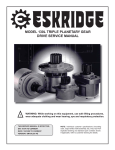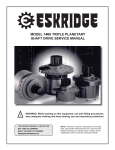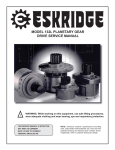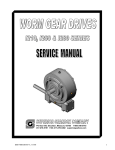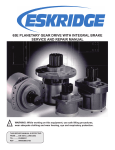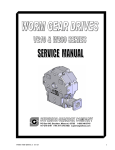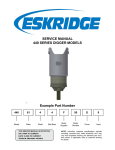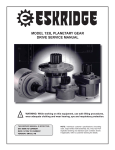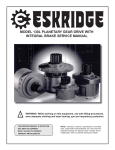Download model 1000 double planetary spindle drive service manual
Transcript
MODEL 1000 DOUBLE PLANETARY SPINDLE DRIVE SERVICE MANUAL ! WARNING: While working on this equipment, use safe lifting procedures, wear adequate clothing and wear hearing, eye and respiratory protection. THIS SERVICE MANUAL IS EFFECTIVE: S/N:25000 TO CURRENT DATE:02/01/1996 TO CURRENT VERSION: SM1000LS2-AD NOTE: Individual customer specifications (mounting case, output shaft, brake assembly, etc.) may vary from exploded drawing and standard part numbers shown. If applicable, refer to customer drawing for details. 55 54 53 42 SIMPLE PRIMARY 43 38 46 2 COMPOUND PRIMARY 32 9 17 33 22 45 31 22 30 29 29 19 12 6 13 22 22 16 39 10 8 48 18 47 27 28 39 5 37 11 37 33 MODEL 1000L SPINDLE OUTPUT 28 27 7 21 35 14 EFFECTIVE S/N 75300 - UP EFFECTIVE DATE 06/19/07 25 15 *UNITS MANUFACTURED PRIOR TO S/N 75300 UTILIZE (OBSOLETE) P/N 60-004-1301 FOR ITEM 22. USE OF P/N 60-004-1881 WILL MAKE OLDER UNITS IDENTICAL TO CURRENT UNIT (SHOWN ON THIS DRAWING) 33 26 20 21 36 R EQUIPPED WITH PATENTED "LOAD-N-LOCK" SHAFT RETENTION SYSTEM (U.S. PATENT NO.5746517). 1 NOTES: 42 -J- BEARING PRELOAD DETERMINES QUANTITY OF SHIMS. 50 56 SEAL KIT (P/N 60-016-2101) INCLUDES: 3 EA. ITEM (33) O-RINGS, 1 EA. ITEM (49) SEAL, AND 1 EA. ITEM (50) SEAL BOOT. 23 24 49 3 X1000LS2-AD, X1000LS2-AD DATE 06-13-07 ECN 2681 Page 1 of 2 52 57 51 Effective date 07/01/2007 58 Effective serial # 74362 Model 1000 Spindle Drive service manual, SM1000LS2-AD Page 1 Eskridge, Inc. Olathe, Ks. 913-782-1238 www.eskridgeinc.com MODEL 1000L SPINDLE DRIVE BASE 1 2 1 3 1 5 6 7 8 9 10 11 12 13 14 15 16 1 1 1 1 1 3 3 1 -J1 SPLINE ADAPT . INPUT GEAR . SPINDLE SHAFT 1 COVER ITEM QTY. X1000LS2-AD Page 2 of 2 Effective date 07/01/2007 Effective serial # 74362 17 1 18 19 20 21 22 23 24 25 26 27 28 29 30 31 32 33 35 36 37 38 39 42 43 45 46 47 48 49 50 51 52 3 3 -J6 6 1 1 1 1 6 6 6 1 2 1 3 1 3 6 1 6 6 20 12 20 1 3 1 1 1 1 53 1 54 55 56 57 58 (1) (1) (-) (12 ) 1 SIMPLE PRIMARY RATIOS DESCRIPTION CODE F - FLANGELESS CODE F - FLANGELESS W/ZERK GREASE FITTING CODE A - FLANGED CODE A - FLANGED W/ZERK GREASE FITTING 600C_ - CUSTOM MTG - PER CUSTOMER SPECS. COVER - SAE `C' (2 AND 4 BOLT) COVER - SAE `D' (4 BOLT) COVER - SAE `E' (4 BOLT) CODE S1 - 17" DIA ; 12X 1 1/8 - 12 UNF-2B CODE S2 - 17" DIA.; 12X 1.225 DIA. THRU HOLES CODE C1 - SPINDLE - CUSTOM CARRIER - SECONDARY CARRIER - PRIMARY RING GEAR - SECONDARY RING GEAR - SIMPLE PRIMARY RING GEAR - COMPOUND PRIMARY RING SPACER - PRIMARY PLANET GEAR - SECONDARY PLANET GEAR - PRIMARY CLUSTER GEAR LOCK RING - SHAFT BEARING SHIM(S) - SHAFT SUN GEAR CODE 9 - (13T; 8/16 SPLINE) CODE 8 - (16T; 8/16 SPLINE) PLANET SHAFT-SECONDARY PLANET SHAFT-PRIMARY SHIM(S) - SECONDARY PLANET WASHER - SECONDARY PLANET WASHER - PRIMARY PLANET BEARING CONE - SHAFT OUTER BEARING CUP - SHAFT OUTER BEARING CONE - SHAFT INNER BEARING CUP - SHAFT INNER CONE - SEC.PLANET CUP - SEC.PLANET BRG-PRIMARY PLANET BRG-PRI. CARR. THRUST RACE-PRI. CARR. THRUST RACE- INPUT THRUST O-RING - RING GEAR SPLIT RING RETAINING RING -SEC. PIN RETAINING RING-SEC. PLNT. RETAINING RING - INPUT ROLL PIN - PRI. 1/4 X 1 3/8 PIPE PLUG 3/4 NPT MAGNETIC H.H.C.S 3/4-10 X 10.5 GRD 8 S.H.C.S 1/2-13 X 1.5 GRD 8 HARDWASHER - 3/4 RING - SEC CARRIER RETAINER FLAT HD. SOC. C.S. 3/8-24 X 1 GR8 SEAL - METAL FACE SEAL - RUBBER FACE PIPE PLUG (1/8 NPT-HOLLOW HEX) GREASE FITTING-STRAIGHT, 1/8 NPT CODE 4;: 14T, 12/24 D.P. (OPTIONAL) CODE 7: 17T, 12/24 D.P. (OPTIONAL) CODE V - AIR VENT; 1/8 NPT ADAPTER ; 3/4" NPT-M, 1/8" NPT - F CODE Z - GREASE FIT.-STR., 1/4 NPT CODE S - SPINDLE STUDS PIPE PLUG (1/4 NPT) (OPTIONAL) (OPTIONAL) (OPTIONAL) (OPTIONAL) COMPOUND PRIMARY 26.48:1 41.41:1 75.60:1 96.00:1 PART NUMBER PART NUMBER PART NUMBER PART NUMBER 60-004-3034 60-004-3034Z 60-004-3044 60-004-3044Z 60-004-3034 60-004-3034Z 60-004-3044 60-004-3044Z 60-004-3034 60-004-3034Z 60-004-3044 60-004-3044Z 60-004-3034 60-004-3034Z 60-004-3044 60-004-3044Z 60-004-1064 60-004-1074 60-004-1564 60-004-4052L 60-004-4122L 60-004-1064 60-004-1074 60-004-1564 60-004-4052L 60-004-4122L 60-004-1064 60-004-1074 60-004-1564 60-004-4052L 60-004-4122L 60-004-1064 60-004-1074 60-004-1564 60-004-4052L 60-004-4122L 60-004-1044 60-004-1014 60-004-1243 60-004-1193 60-004-1232 60-004-1132 60-004-1472 60-004-1311 60-004-1222 60-004-1122 60-004-1402 60-004-1262 60-004-1272 60-004-1321 60-004-1291 60-004-1881 01-102-0190 01-103-0190 01-102-0230 01-103-0230 01-102-0210 01-103-0210 01-105-0510 01-112-0340 01-112-0350 01-112-0060 01-402-0660 60-004-1482 01-160-0490 01-160-0500 01-160-0510 01-153-0150 01-207-0100 01-150-1580 01-166-0350 60-004-1352 01-150-1590 01-406-0010 01-406-0020 01-207-0030 01-215-0010 98-005-1141 60-004-1523 01-216-0030 01-201-0530 01-215-0040 01-164-0050 01-207-0020 60-004-1044 60-004-1024 60-004-1243 60-004-1193 60-004-1232 60-004-1152 60-004-1472 60-004-1311 60-004-1222 60-004-1142 60-004-1492 60-004-1262 60-004-1272 60-004-1321 60-004-1291 60-004-1881 01-102-0190 01-103-0190 01-102-0230 01-103-0230 01-102-0210 01-103-0210 01-105-0510 01-112-0340 01-112-0350 01-112-0060 01-402-0660 60-004-1482 01-160-0490 01-160-0500 01-160-0510 01-153-0150 01-207-0100 01-150-1580 01-166-0350 60-004-1352 01-150-1590 01-406-0010 01-406-0020 01-207-0030 01-215-0010 98-005-1141 60-004-1523 01-216-0030 01-201-0530 01-215-0040 01-164-0050 60-004-1044 60-004-1024 60-004-1243 60-004-1213 60-004-1253 60-004-1232 60-004-1162 60-004-1472 60-004-1311 60-004-1222 60-004-1142 60-004-1492 60-004-1262 60-004-1272 60-004-1321 60-004-1291 60-004-1881 01-102-0190 01-103-0190 01-102-0230 01-103-0230 01-102-0210 01-103-0210 01-105-0510 01-112-0340 01-112-0350 01-112-0060 01-402-0660 60-004-1482 01-160-0490 01-160-0500 01-160-0510 01-153-0150 01-207-0100 01-150-1580 01-150-0570 01-166-0350 60-004-1352 01-150-1590 01-406-0010 01-406-0020 01-207-0030 01-215-0010 98-004-1141 60-004-1523 01-216-0030 01-201-0530 01-215-0040 01-164-0050 01-207-0020 01-207-0020 60-004-1044 60-004-1024 60-004-1243 60-004-1213 60-004-1253 60-004-1232 60-004-1182 60-004-1472 60-004-1311 60-004-1222 60-004-1172 60-004-1452 60-004-1262 60-004-1272 60-004-1321 60-004-1291 60-004-1881 01-102-0190 01-103-0190 01-102-0230 01-103-0230 01-102-0210 01-103-0210 01-105-0510 01-112-0340 01-112-0350 01-112-0060 01-402-0660 60-004-1482 01-160-0490 01-160-0500 01-160-0510 01-153-0150 01-207-0100 01-150-1580 01-150-0570 01-166-0350 60-004-1352 01-150-1590 01-406-0010 01-406-0020 01-207-0030 01-215-0010 98-004-1141 60-004-1523 01-216-0030 01-201-0530 01-215-0040 01-164-0050 01-207-0020 Model 1000 Spindle Drive service manual, SM1000LS2-AD Page 2 Eskridge, Inc. Olathe, Ks. 913-782-1238 www.eskridgeinc.com LUBRICATION & MAINTENANCE Using the chart below, determine an appropriate lubricant viscosity. Use only EP (extreme pressure) or API GL-5 designated lubricants. Change the lubricant after the first 50 hours of operation and at 500 hour intervals thereafter. The gear drive should be partially disassembled to inspect gears and bearings at 1000 hour intervals. Recommended ambient and operating temperatures for conventional and synthetic gear lubricants -50 -25 0 25 50 75 100 125 150 175 200 225 250 F 107 121 C 80W90 conventional 75W90 conventional 85W140 conventional Min Ambient/operating temp Max Operating temp Max Ambient temp 75W90 synthetic 80W140 synthetic -45 -32 -18 -4 10 24 38 52 66 79 93 Note: Ambient temperature is the air temperature measured in the immediate vicinity of the gearbox. A Gearbox exposed to the direct rays of the sun or other radiant heat sources will operate at higher temperatures and therefore must be given special consideration. The max operating temp must not be exceeded under any circumstances, regardless of ambient temperature. ESKRIDGE MODEL 1000 OIL CAPACITIES Operating Position Oil Capacity Oil Level Single stage Double stage Triple stage Horizontal Shaft - 17 qts / 16 Liters 19 qts / 18 Liters To horizontal centerline of gear drive Vertical Shaft (Pinion Up) - 26 qts / 24 Liters 28 qts / 26 Liters To side port on gear drive base 29 qts / 27 Liters 32 qts / 30 Liters To midway on upper/ primary gear set Vertical Shaft (Pinion Down) ESKRIDGE PART NUMBER INTERPRETATION Note: All standard Eskridge Geardrives are issued a descriptive part number which includes information regarding the Model, means of shaft retention, base style, shaft style, input mounting, input shaft size, overall ratio and various available options. For a detailed breakdown of this information, please refer to Eskridge product specification sheets found at: http://www.eskridgeinc.com/geardrives/gearprodspecs.html Model 1000 Spindle Drive service manual, SM1000LS2-AD Page 3 Eskridge, Inc. Olathe, Ks. 913-782-1238 www.eskridgeinc.com Unit Teardown 1) Scribe a diagonal line across the outside of the unit from the cover (2) to the base (1) before disassembly to aid in the proper positioning of pieces during reassembly. 2) Remove drain plugs (42) and drain oil from unit. The oil will drain out more quickly and completely if warm. 3) Remove the 20 3/4-10 capscrews lockwashers (46) retaining the cover (2). 4) Remove the cover (2), thrust washer(s)/bearing(s) (30,31,32), and input gear (17). Inspect o-ring (33); discard if damaged or deformed. (43) and 5) Lift the planet carrier assembly out of the unit . 6) Remove ring gear(s)/spacer (8/10pri, 7sec) and subsequent carrier assemblies. Inspect gear to gear and gear to base Oring(s) (33); as before, discard if damaged or deformed. 7) The unit is now disassembled into groups of parts. The area(s) requiring service should be identified by thorough inspection of the individual components after they have been cleaned and dried. Carrier Assembly Teardown Rotate planet gears (12/13 pri;11 sec) to check for abnormal noise or roughness in bearings. If further inspection or replacement is required, proceed as follows. 1) Primary: Drive roll pins (39) completely into the planet shafts (19). Secondary: Remove planet shaft retaining rings (36), spacers (21) and preload shims (20) 2) Slide planet shafts (19 pri/18 sec) out of carrier. 3) Remove planet gears (12/13 pri; 11 sec), washers (22 pri/21 sec) and bearings (29 pri;27/28 sec) from carrier (6). 4) Inspect the planet gear (12/13 pri; 11 sec), bearing bore and planet shaft (19 pri/18 sec) and bearings (29 pri; 27/28 sec). Check for spalling, bruising or other damage and replace components as necessary. 5) Primary only: Remove roll pins (39) from planet shafts (19) using a 1/4 inch pin punch. Caution: Since the shaft is no longer positively retained, care should be taken to avoid injury. Care should also be taken not to damage it while pressing through base. 2) Place base (1) exterior side down, on a plate or table. Press output shaft out bottom of base by applying a load to internal end of spindle (3) until it passes through inner spindle bearing cone (25). 3) A gear puller may be used to remove the outer bearing cone (23) from the spindle (3). If reusing old bearing cone, do not pull on or damage roller cage. Note: Press bearing cone onto output spindle by pressing on inner race only. DO NOT press on roller cage, as it may damage the bearing assembly. 4) Inspect inner and outer bearing cups (26 & 24). If cups are damaged they must be replaced, drive them out using a brass drift and utilizing the bearing knock-out notches in the base (1) 1) Clean all foreign material from magnetic oil plugs located In base (1). 2) Place base exterior side up on work table. 3) Apply a layer of lithium or general purpose bearing grease to the roller contact surface of outer bearing cup (24). 4) Press outer bearing cone (23) onto the spindle (3) until it seats against the shoulder. 5) Wipe the face of each half of the metal face seal (49) using a lint-free wipe. No particles of any kind are permissible on the sealing surfaces. (Even a hair is sufficient to hold the seal surfaces apart and cause a leak.) Apply a thin film of oil on the entire seal face of one or both seals using a clean finger or lint-free applicator. Oil must not contact any surfaces other than the sealing faces. (See Pages 6-8 for seal inspection and service procedures.) 6) Place the spindle (3) with the outer bearing cone into the base. 7) Flip shaft/base assembly, and apply lithium or general purpose bearing grease to roller contact surface of the inner cup (26), then press inner bearing cone (25) onto shaft until it seats against inner bearing cup. 8) Proper spindle bearing preload will result in a rolling torque which varies between 200 to 300 in-lb. The bearing preload should be tailored to your application; a low-speed application may require a high pre-load, while high-speed applications usually benefit from low pre-load. Adding shims (15) will increase the pre-load on the bearing set. Determine your pre-load requirement and install shims to obtain this preload. 9) Install the Load-N-Lock™ halves (35) over the shims and into the corresponding spindle groove. Then, install the lock ring (14) over the Load-n-Lock halves (35B). Base Reassembly Carrier Reassembly 1) Primary: Planet shafts (19) should be installed with chamfered end of 1/4 inch roll pin hole towards outside diameter of carrier (6); this will ease alignment of holes while inserting roll pins (39). Secondary: Planet shafts must be installed aligning the slot in the large end of the shaft with the roll pin protruding into the shaft bore. 2) Primary: Drive roll pin (39) into the carrier hole and into planet shaft to retain parts. Secondary: Install the first planet washer (21) to the small end of the planet shaft, the appropriate number of preload shims (20) and then the second planet washer (21) and retaining ring (36) Repeat for remaining planet gears. 1) Remove the output shaft lock ring (14) using a heel bar or puller; if using a heel bar, be sure not to pry against the cage of the inner spindle bearing (25). Remove the split ring segments (35) and shims (15). Base Subassembly Teardown All subassembly service or repairs should be complete at this time. Continue to Unit Assembly to com- Model 1000 Spindle Drive service manual, SM1000LS2-AD Page 4 Eskridge, Inc. Olathe, Ks. 913-782-1238 www.eskridgeinc.com plete buildup of unit. 8) Install and torque the 20 3/4-10 hex-head capscrews (43) with lockwashers (46). The torque for the cap-screws: 380 ft-lb dry, 280 ft-lb if the fasteners are lubricated. 9) Using a splined shaft to drive the input gear (17) ensure that the unit spins freely. 10) Fill the unit to the proper level, as specified, with recommended gear oil (refer to chart, page 3) after unit is sealed with brake and/or motor. Unit Reassembly 1) Install the secondary carrier assembly onto the output spindle; aligning the splines of the carrier (5) with the output spindle (3) splines and centering the three threaded holes in the ouput spindle between the planet gears. Once aligned slide the carrier onto the spindle. 2) Install carrier retaining plate (47) & secure using provided 3/824 Flathead capscrews (48). If using thread locking compound to assist in screw retention, apply only a small amount to internal threads. Use of excess thread lock may cause screws to be irremovable once compound has cured. 3) Lubricate o-ring (33) and install on the ring gear (7) pilot. The gearbox is now ready to use.The gear drive is now ready to use. Caution: Hold ring gear by outside diameter or use lifting device to prevent injury. 4) Align the gear teeth of secondary ring gear (7) with the gear teeth of the planet gears (11) and place ring gear on base aligning mounting holes of ring gear with holes in base. Use the scribed line made during disassembly for reference. With carrier in place, install secondary sun gear. Simple Planetary Primary, for compound primary skip to step 5C 5S) Install primary ring gear (with lubricated oring in place), align mounting holes of ring gear with holes in base using the scribed line made during disassembly for reference. Install the primary carrier assembly aligning gear teeth of ring gear with those of the planet gears and place on base. Install the input gear (17). Compound primary (76:1 ratio and up): 5C) a) The planet gears will now need to be timed. Refer to the diagram appropriate for your unit’s gear ratio (above, right). The planet gears each have a timing mark, usually a round punch mark stamped into the surface which is shown as a circle on the diagram. b) As seen from above, start with the top planet gear with it’s timing mark pointing straight down. Next, rotate the lower left planet gear counterclockwise as indicated in the timing diagram. Then rotate the lower right planet gear clockwise as indicated. c) Set the input gear (17) and the input thrust race (32) into the center of the primary planet carrier assembly. d) If compound primary ring gear (9) was not removed during disassembly, then skip to step 7. Otherwise, bolt to the inside of the cover (2) with twelve bolts (45). Use a removable thread locking compound on the threads of the bolts (45). Tighten to 110 ft.-lbs. dry or 80 ft.-lbs. lubricated. e) Install primary ring spacer (10) w/ O-ring (33) in place. 6) Install the input to cover thrust washer (32) and carrier to cover thrust washers (31, 2ea; 30, 1ea) Refer to exploded view for details. 7) Noting the scribed line made during disassembly, (with lubricated o-ring in place) align and install the cover (2). Model 1000 Spindle Drive service manual, SM1000LS2-AD Page 5 Eskridge, Inc. Olathe, Ks. 913-782-1238 www.eskridgeinc.com Seal Assembly for Duo-Cone Seals Installation Instructions courtesy Caterpillar, Inc. 5 2 8 4 6 7 3 4 8 2 Seal Assembly Contents: (2) Metal Seal Rings 2 (2) Rubber Toric Rings Terminology: 1 - Seal Ring 6 - Seal Ring Face 2 - Rubber Toric 7 - Seal Ring Ramp 3 - Housing Retainer Lip 8 - Seal Ring Retaining Lip 4 - Housing Ramp 9 - Installation Tool (Optional) 5 - Seal Ring Housing (Base/Shaft) 7 1 Model 1000 Spindle Drive service manual, SM1000LS2-AD Page 6 Eskridge, Inc. Olathe, Ks. 913-782-1238 www.eskridgeinc.com Inspection of Worn Seals Housing Preparation Seals wear in an axial, rather than radial, direction (as depicted in Figure Y). The total thickness of the flange is usable wear material on the formed seal rings and good seal performance can generally be expected until the flange is completely worn away. Remaining service life can be estimated by measuring the ring flange thickness, and using the chart below. Minimum flange thickness required for reusability is 0.05” (1.27 mm). The housing components (3, 4) that contact the rubber toric rings must be free from foreign material (oil, grease, dirt, metal chips dust or lint particles, etc.) before installing the seal. This should be done with a lint-free wipe and a non-petroleum based solvent. Measure Flange Thickness Here 1) Remove any foreign material from the rubber torics (2), ramps (7) and lips (8) of both seal rings. This should also be done with a lint-free wipe and non-petroleum based solvent. 2) Dry with a clean wipe. 3) Place the rubber toric (2) on the metal seal ring (6) at the bottom of the seal ring ramp (7) and against the retaining lip (8) (see illustration on previous page). Make sure the rubber toric is straight on the seal ring and not twisted. Be careful not to nick or cut the torics during this assembly, as this can cause leaks. 4) Put the installation tool (9) onto the metal seal ring (6) and rubber toric (2). Lightly dampen the lower half of the rubber toric with the appropriate assembly lubricant. Techniques to dampen the toric include wiping with a lint-free towel, lubricating using a clean foam brush, or dipping into a container lined with towels saturated in the assembly lubricant (as shown). Development of a Wear Lip in This Area Makes it Necessary to Install a New Seal 9 Figure Y The measured parameter used to check the remaining seal life is flange thickness, at the outer edge (once any wear lip is removed). The measurement must be made carefully because the shoulder is only 0.06” (1.52 mm) from the edge of the flange. 2 1 Estimates of expected seal life are difficult, because there are many differences in machine applications, job conditions, maintenance and other factors that affect seal service life. Formed Seal Wear Chart Seal Wear Percent Worn Approved Assembly Lubricants* 0.075 (1.91) 0 Houghto-Grind 60 CT 0.062 (1.59) 25 0.050 (1.27) 50 0.038 (0.95) 75 0.025 (0.64) 100 0.012 (0.32) 125 0.000 (0.00) 150 Flange Thickness in (mm) Isopropyl Alcohol Quaker® Solvo Clean 68-RAH *Do not use Stanosol or any other liquid that leaves an oil film or does not evaporate quickly. Mishandling Of Seals Mishandling of seals during assembly can cause immediate leaks or premature failure. Failure can occur due to cutting or tearing of the elastomeric load ring, breakage of the sealing ring, contamination of the sealing face with dirt or lint, etc. When assembling metal face seals, please carefully observe assembly instructions. Model 1000 Spindle Drive service manual, SM1000LS2-AD Page 7 Eskridge, Inc. Olathe, Ks. 913-782-1238 www.eskridgeinc.com Installation Process 1) With the lower half of the rubber toric still wet, use the installation tool (9) to position the seal ring (1) and the rubber toric (2) squarely against the housing retainer lip (3) (as shown). 2) For smaller diameter seals, use sudden and even pressure to push the rubber toric under the retaining lip of the housing. For larger diameter seals, which will not press in with sudden and even pressure, it is acceptable to work the toric past the retaining lip by starting on one side and tapping the opposite side of the installation tool with a rubber mallet until it is engaged past the retaining lip of the housing. 3) Check the assembled height (A) (see below) in at least four places, 90º apart, using either a caliper, tool makers’ ruler or any other calibrated measuring device. The difference in height around the ring must not be more than 0.04” (1 mm). If small adjustments are necessary, do not push or pull directly on the seal ring. Use the installation tool (9) to push down and your fingers to pull up uniformly on the rubber toric and seal ring. NOTE: The rubber toric can twist if it is not completely wet during installation or if there are burrs or fins on the retaining lip of the housing. Twists, misalignments and bulges of the toric will result in seal failure. If correct installation is not apparent, remove seal from the housing and repeat the process. The rubber toric must never slip on the ramps of either the seal ring or the housing. To prevent slippage, allow adequate evaporation time for the lubricant before proceeding with further assembly. Once correctly in place, the rubber toric must roll on the ramp only. 4) Wipe each seal ring face (6) using a lint-free wipe. No particles of any kind are permissible on the sealing surfaces. (Even a hair is sufficient to hold the seal surfaces apart and cause a leak.) 5) Apply a thin film of oil on the entire seal face (6) of one or both seals using a clean finger or lint-free applicator. Oil must not contact surfaces other than the sealing faces. Dim A NOTE: Mishandling of seals during assembly can cause immediate leaks or premature failure. Failure can occur due to curing or tearing of the elastromeric load ring, breakage of the sealing ring, contamination of the sealing face with dirt or lint, etc. When assembling metal face seals, please carefully observe assembly instructions. Final Assembly While completing the final assembly of the unit, make sure that both housings are in correct alignment and are concentric. Slowly bring the two housings together. High impact can scratch or break the seal components. If the rubber toric slips at any location, it will twist, causing the seal rings to cock. Any wobbling motion of the seal is an indication of cocked seals and can cause dirt to enter by pumping mud past the torics. Model 1000 Spindle Drive service manual, SM1000LS2-AD Page 8 Eskridge, Inc. Olathe, Ks. 913-782-1238 www.eskridgeinc.com













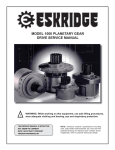

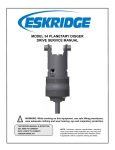
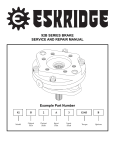
![E-CORE[イー・コア]直管形LEDベースライト モデルチェンジのお知らせ](http://vs1.manualzilla.com/store/data/006543989_3-984d60b7a35b5c906359937cb576f3e5-150x150.png)


